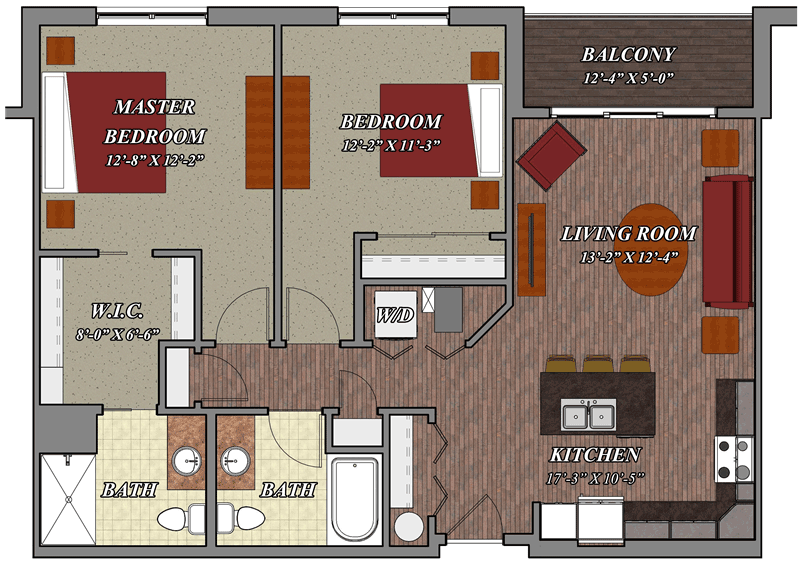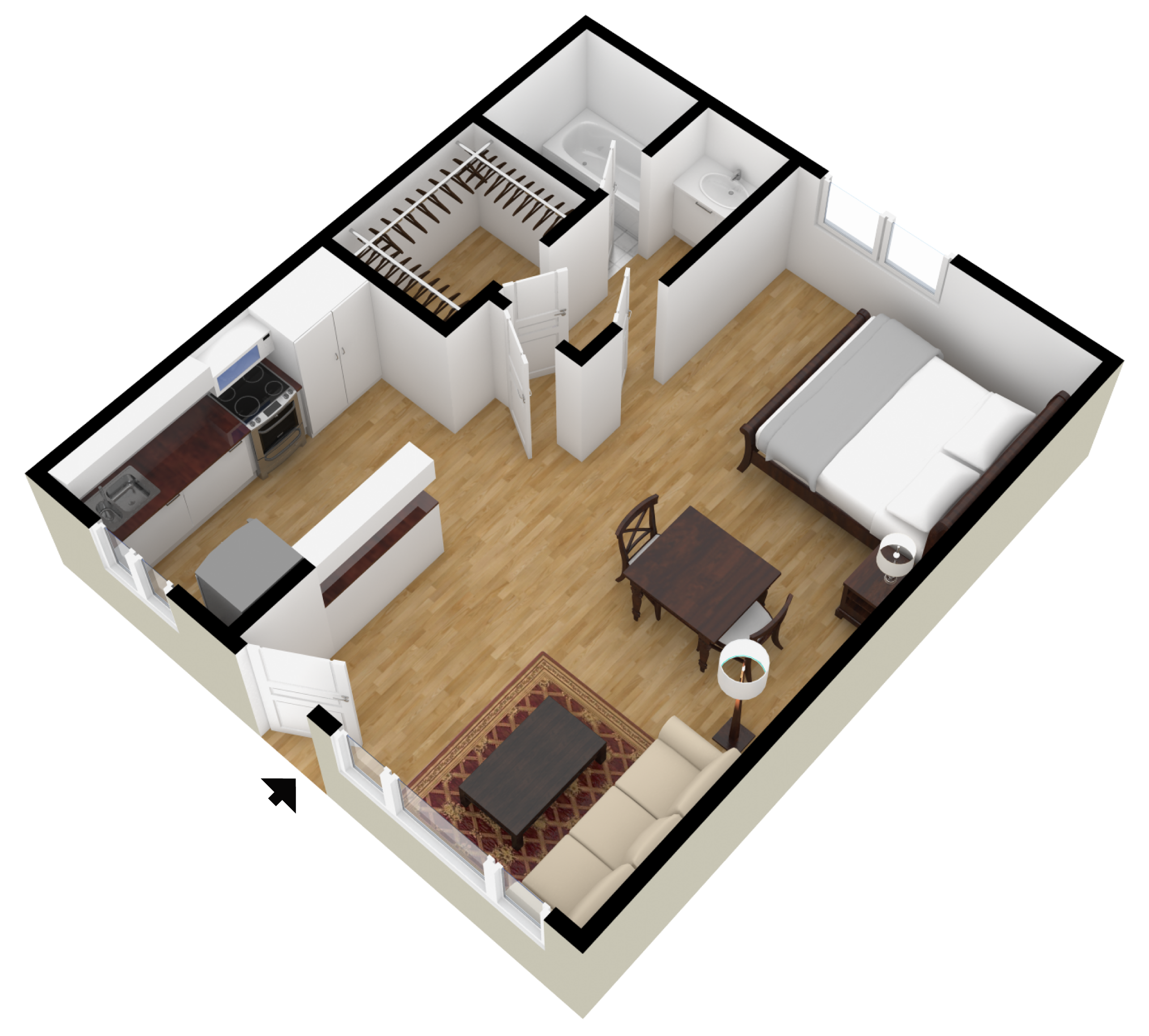Understanding Square Footage in 2-Bedroom Apartments: Square Footage 2 Bedroom Apartment
Square footage is a crucial factor to consider when searching for a 2-bedroom apartment. It directly impacts the living space available, influencing the overall layout, functionality, and comfort of your home.
The Importance of Square Footage
Square footage, measured in square feet, represents the total usable floor area of a space. In the context of a 2-bedroom apartment, square footage determines the size of each room, the overall flow of the apartment, and the amount of space available for furniture and personal belongings. A larger square footage generally translates to more spacious rooms, potentially including features like walk-in closets, separate dining areas, or even a home office. Conversely, a smaller square footage may necessitate more efficient furniture arrangements and creative storage solutions.
Impact of Square Footage on Layout and Functionality
Square footage plays a significant role in shaping the layout and functionality of a 2-bedroom apartment. For instance, a 2-bedroom apartment with 800 square feet might have a more open floor plan with a combined living and dining area, while a 1,000 square foot apartment could accommodate a separate dining room and a larger kitchen.
Examples of Different Layouts
2-Bedroom Apartments with Varying Square Footage
Here are examples of different layouts for 2-bedroom apartments with varying square footage:
- 800 square feet: This layout typically features an open living/dining area, two bedrooms, a kitchen, and one bathroom. The bedrooms might be smaller, and there might be limited space for additional furniture or storage.
- 1,000 square feet: This layout can offer a more spacious living room, separate dining area, two bedrooms, a larger kitchen, and possibly two bathrooms. The bedrooms might be larger, and there could be more space for furniture and storage.
- 1,200 square feet: This layout might include all the features of a 1,000 square foot apartment, plus additional space for a home office, a laundry room, or even a guest bedroom. The bedrooms would be spacious, and there would be ample space for furniture and storage.
Tips for Maximizing Space
- Utilize vertical space: Install shelves, cabinets, and organizers to make the most of vertical space. This is especially helpful in smaller apartments where floor space is limited.
- Choose multi-functional furniture: Opt for furniture that serves multiple purposes, such as a sofa bed or a coffee table with storage space. This can help maximize space and functionality.
- Minimize clutter: Regularly declutter your apartment to avoid overcrowding and maintain a sense of spaciousness. Consider donating or selling items you no longer need.
- Use mirrors: Mirrors can create an illusion of more space by reflecting light and making the room appear larger.
- Light colors: Painting walls in light colors can help create a sense of spaciousness and openness.
Common Features in 2-Bedroom Apartments
The features found in a 2-bedroom apartment can vary depending on the square footage and the building’s amenities.
- Smaller apartments: These often have a more compact layout, with a combined living/dining area, a smaller kitchen, and one bathroom. The bedrooms may be smaller, and there might be limited space for storage.
- Larger apartments: These might offer separate dining areas, larger kitchens, two bathrooms, and potentially a home office or a guest bedroom. The bedrooms would be spacious, and there would be ample space for furniture and storage.
Factors Influencing Square Footage Requirements

Finding the perfect 2-bedroom apartment involves a careful consideration of your individual needs and lifestyle. The square footage you require is a key aspect of this search, and several factors play a crucial role in determining the ideal size for you.
Personal Lifestyle and Preferences
The way you live impacts your square footage needs. Consider your hobbies, whether you frequently host guests, and if you prefer a minimalist or a more curated living style.
- Entertaining: Do you enjoy hosting dinner parties or large gatherings? If so, you’ll need a spacious living area and dining room to accommodate your guests comfortably.
- Work from Home: If you work from home, a dedicated workspace is essential. This could be a separate home office or a designated area within a larger room.
- Hobbies: Do you have hobbies that require dedicated space, like painting, playing music, or crafting? Factor in the space needed for your equipment and materials.
- Storage: Do you have a lot of belongings? Consider the storage space you need, including closets, cabinets, and perhaps a dedicated storage room.
Square Footage Requirements for Different Apartment Types
The type of 2-bedroom apartment you choose significantly influences its square footage.
- Studio Apartments: While typically smaller, studios often have a more open layout, maximizing space with creative design. You might find a 2-bedroom studio, where the bedrooms are separated by a wall or a divider.
- Loft Apartments: Lofts often feature high ceilings and open floor plans, offering a sense of spaciousness. While the square footage might be similar to a traditional apartment, the layout can make it feel larger.
- Townhouses: Townhouses generally offer more space than apartments, with separate floors and often private outdoor areas. This translates to a larger square footage compared to a standard apartment.
Common Square Footage Ranges for 2-Bedroom Apartments
Here’s a table showcasing common square footage ranges for 2-bedroom apartments in different cities and neighborhoods, based on data from real estate websites and market research:
| City/Neighborhood | Average Square Footage Range |
|—|—|
| New York City (Manhattan) | 800 – 1,200 sq ft |
| San Francisco | 900 – 1,400 sq ft |
| Los Angeles (Downtown) | 1,000 – 1,500 sq ft |
| Chicago (Loop) | 900 – 1,300 sq ft |
| Seattle (Downtown) | 850 – 1,250 sq ft |
Visual Representation of Space Utilization
Imagine two 2-bedroom apartments, one with 800 square feet and another with 1,200 square feet. The smaller apartment might have compact bedrooms, a combined living/dining area, and limited storage space. The larger apartment could feature spacious bedrooms, a dedicated dining room, a home office, and ample storage. This difference in square footage directly impacts how you can utilize the space, influencing your comfort and overall living experience.
Exploring the Benefits and Drawbacks of Different Square Footage Options

The square footage of a 2-bedroom apartment plays a significant role in defining your living experience. It’s not just about the numbers; it’s about how those numbers translate into the quality of your daily life. Let’s explore the benefits and drawbacks of different square footage options to help you make an informed decision.
Living in a 2-Bedroom Apartment with Smaller Square Footage
Living in a smaller 2-bedroom apartment can be a practical choice, especially if you prioritize affordability or prefer a cozy, intimate environment.
- Lower Rent or Mortgage: One of the most significant advantages of a smaller apartment is its affordability. Lower square footage generally translates to lower rent or mortgage payments, freeing up more of your budget for other expenses.
- Less Cleaning and Maintenance: A smaller space means less cleaning and maintenance. This can be a significant benefit for busy individuals or those who prefer a more minimalist lifestyle.
- Potential for a More Cohesive and Intimate Atmosphere: A smaller space can create a sense of intimacy and closeness, fostering a more cohesive living environment for roommates or families.
However, there are also some potential drawbacks to consider:
- Limited Space for Furniture and Storage: Smaller apartments can present challenges when it comes to accommodating furniture and storage needs. Careful planning and multi-functional furniture are essential.
- Potential for Feeling Crowded: While some may appreciate the cozy atmosphere, others might find a smaller apartment too cramped, especially with multiple occupants.
- Less Natural Light: Smaller apartments often have fewer windows, which can lead to less natural light penetration.
Living in a 2-Bedroom Apartment with Larger Square Footage
A larger 2-bedroom apartment offers more space and flexibility, catering to those who value spaciousness and comfort.
- More Space for Furniture and Storage: Larger apartments provide ample room for furniture and storage, making it easier to organize belongings and create dedicated spaces for different activities.
- Increased Comfort and Privacy: With more space, you can enjoy greater comfort and privacy, allowing for individual retreat and a more relaxed living experience.
- Potential for More Natural Light: Larger apartments often have more windows, providing greater natural light penetration and a brighter living environment.
However, larger apartments also come with some challenges:
- Higher Rent or Mortgage: The cost of living in a larger apartment is typically higher due to increased square footage and associated expenses.
- Increased Cleaning and Maintenance: Larger spaces require more time and effort for cleaning and maintenance, which can be a burden for some individuals.
- Potential for Feeling Empty or Uncoordinated: A larger apartment might feel empty or uncoordinated if not properly furnished and decorated, requiring more effort to create a warm and inviting atmosphere.
Tips for Making the Most of a 2-Bedroom Apartment with Limited Square Footage, Square footage 2 bedroom apartment
- Maximize Vertical Space: Utilize shelves, wall-mounted organizers, and multi-tiered furniture to maximize vertical space and create efficient storage solutions.
- Choose Multi-Functional Furniture: Opt for furniture that serves multiple purposes, such as a sofa bed or a coffee table with storage compartments.
- Keep It Minimal: Embrace a minimalist approach to decluttering and only keep essential items, creating a sense of spaciousness and order.
- Use Mirrors to Create an Illusion of Space: Mirrors can reflect light and create the illusion of a larger space, making a small apartment feel more open and airy.
- Use Light Colors: Light colors on walls and furniture can help reflect light and make a small space appear larger.
Potential Challenges and Solutions Associated with Living in a 2-Bedroom Apartment with Larger Square Footage
- Feeling Overwhelmed by Space: A larger apartment can sometimes feel overwhelming, especially if you’re accustomed to a smaller living space. Consider creating distinct zones within the apartment to define different areas and create a sense of order.
- Higher Utility Bills: Larger apartments generally require more energy to heat and cool, leading to higher utility bills. Consider energy-efficient appliances and practices to minimize costs.
- Difficult to Furnish and Decorate: Furnishing and decorating a larger apartment can be a challenge, requiring more effort and potentially a larger budget. Start with a basic layout and gradually add furniture and decor to create a cohesive and comfortable living space.
Summary of Benefits and Drawbacks of Different Square Footage Options for 2-Bedroom Apartments
| Square Footage Option | Benefits | Drawbacks |
|---|---|---|
| Smaller Square Footage | Lower rent or mortgage, less cleaning and maintenance, potential for a more cohesive and intimate atmosphere | Limited space for furniture and storage, potential for feeling crowded, less natural light |
| Larger Square Footage | More space for furniture and storage, increased comfort and privacy, potential for more natural light | Higher rent or mortgage, increased cleaning and maintenance, potential for feeling empty or uncoordinated |
